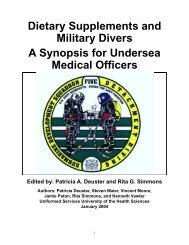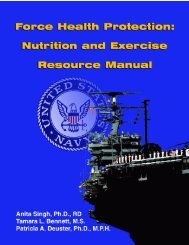Create successful ePaper yourself
Turn your PDF publications into a flip-book with our unique Google optimized e-Paper software.
10 <strong>Tips</strong> <strong>for</strong> <strong>Grocery</strong> <strong>Shopping</strong><br />
1. Plan ahead by using a shopping list.<br />
Make your shopping list based on the menus and stick to the list once<br />
you get to the store. Sticking to a pre-planned list will help you avoid<br />
purchasing items that your waist.<br />
2. Shop the perimeter of the store to include<br />
all food groups.<br />
The perimeter is usually where you will find naturally nutrient-rich<br />
foods. Choose fresh, whole, unprocessed foods as much as possible.<br />
These foods are typically higher in fiber, lower in sugar & salt, and<br />
more nutrient dense.<br />
3. Choose a colorful array of fresh fruits and<br />
vegetables.<br />
Fresh produce is typically packed with nutrients and fiber; the more<br />
colorful your intake, the more vitamins & minerals you consume.<br />
Frozen produce can have a similar nutrient profile to fresh as long<br />
as nothing has been added to it (i.e. sauces, gravies, syrups). Canned<br />
vegetables tend to be high in sodium, but there are some lower<br />
sodium options available.<br />
4. Choose whole grains products with good<br />
sources of dietary fiber.<br />
Whole grain products are typically higher in fiber and will take<br />
longer <strong>for</strong> the body to digest, keeping you satisfied longer. Beware<br />
of breads, cereals, and other grain products that claim to be made<br />
from whole grains but are not high in fiber. Select only high fiber<br />
whole grains that list whole grain flour as the first ingredient. Choose<br />
breads that contain at least 2 grams of dietary fiber per slice and<br />
cereals that contain at least 3 grams of fiber per serving.<br />
5. Choose fat free or low fat dairy products.<br />
Fat free and low fat dairy products contain the same amount of<br />
“good stuff” (i.e. calcium, vitamins A & D) as full fat dairy products<br />
without the extra fat and calories. Select skim or 1% milk, low fat<br />
yogurts and cheeses.<br />
6. Choose lean protein sources.<br />
Consume breast or white meat poultry without the skin. Select lean<br />
cuts of beef and veal, without much marbling, lean center cuts of<br />
pork and lamb. Any type of fish can be used, but make sure to vary<br />
the types of fish consumed because of the risk of contaminants.
7. Consider meat alternatives such as beans,<br />
soy and tempeh.<br />
These include legumes (beans, peas, and lentils), soy protein (tofu,<br />
soybeans), natural peanut or almond butter and other products.<br />
Many of these are low in saturated fat and sodium, contain little<br />
to no cholesterol, and are high in fiber.<br />
8. Choose heart healthy fats such as olive<br />
and canola oils.<br />
All fats are not created equal. Saturated and trans fats can increase<br />
your risk <strong>for</strong> heart disease by adversely affecting the cholesterol<br />
levels in your blood. Monounsaturated fats, such as olive, canola &<br />
peanut oils, are considered the most heart friendly fats and are the<br />
fats recommended <strong>for</strong> consumption. However, it is important to<br />
remember that all fats contain the same amount of calories per<br />
gram, there<strong>for</strong>e fat, regardless of the type, must be used sparingly.<br />
9. Choose beverages wisely avoiding corn<br />
syrups and sugars.<br />
Many people consume a large number of calories through beverages<br />
without realizing it. These calories are typically referred to as “empty<br />
calories” because they provide little nutritional value. Beverages that<br />
fall into this category include alcohol, regular soda and other sweetened<br />
beverages like juice mix, Kool-Aid, sweet tea, sports drinks, etc.<br />
Limit your intake of these beverages to avoid excess calorie intake.<br />
If consuming alcohol, do so in moderation (see section on alcohol in<br />
Chapter 12, Enemy Agents). If drinking juice, ensure it is 100% fruit<br />
juice and remember that it is more beneficial to eat the piece of fruit<br />
than to drink the juice.<br />
10. Choose com<strong>for</strong>t foods with discretion<br />
by reviewing Nutrition Labels.<br />
You don’t need to completely give up “junk food” (chips, cookies, ice<br />
cream, etc.); just enjoy these foods less frequently and in moderate<br />
portions. If you will be tempted to eat these foods on a daily basis,<br />
don’t keep them in the house. For example, if you love ice cream but<br />
know you will eat it every night if it’s in the freezer, don’t buy it and<br />
go out <strong>for</strong> an ice cream cone once in a while.


![Tips for Grocery Shopping [PDF]](https://img.yumpu.com/37447379/1/500x640/tips-for-grocery-shopping-pdf.jpg)

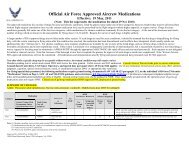

![Body Composition and Military [PDF] - Human Performance ...](https://img.yumpu.com/43269347/1/190x245/body-composition-and-military-pdf-human-performance-.jpg?quality=85)
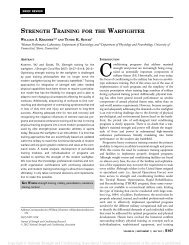
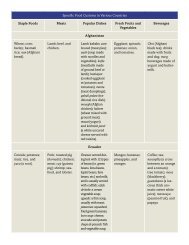
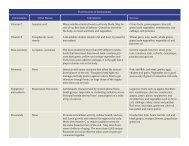
![Synthetic Drugs [PDF] - Human Performance Resource Center](https://img.yumpu.com/37447322/1/190x245/synthetic-drugs-pdf-human-performance-resource-center.jpg?quality=85)
